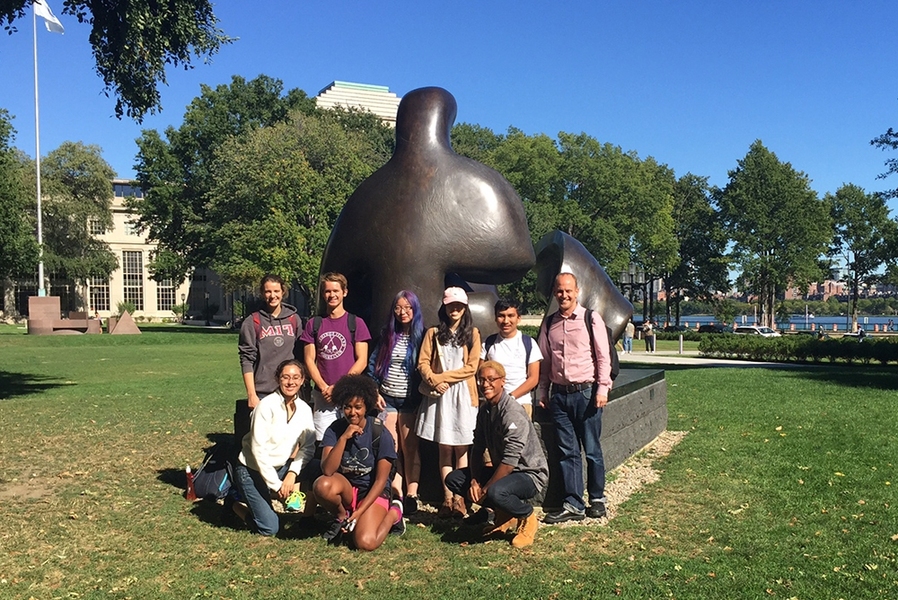On a crisp afternoon in early September, seven MIT freshmen set out on a campus tour with their faculty advisor, John Ochsendorf, the Class of 1942 Professor in Architecture and Professor of Civil and Environmental Engineering. Their first stop was “The Big Sail,” the 33-ton steel sculpture by Alexander Calder that stands in McDermott Court.
“We tend to think of art, architecture, and engineering as separate disciplines,” says Ochsendorf, who taught the first edition of freshmen seminar 4.A06 (Art, Engineering, and Architecture) this fall. “But they are more closely linked than we can ever imagine. And the barriers between them are extremely porous. Calder, for example, is one of the greatest artists of the 20th century. But his mobiles and sculptures are also explorations in equilibrium. And while he’s definitely an artist, he was trained as an engineer.”
Ochsendorf’s weekly two-hour seminar was conceived to help students explore the fertile intersections of art, technology, and design at MIT and beyond. Over the semester, students investigated the many artworks on campus, met with faculty and visiting artists and designers, made frequent field trips to local museums and buildings, and attended a concert by cellist Yo-Yo Ma at Boston Symphony Hall.
“My initial goal was simply to take the students to area museums,” says Ochsendorf, whose own research spans architectural design, masonry mechanics, and the history of construction. “But it quickly evolved as the students began to express their interests. Soon the seminar goal became to help students see the campus and the world around them. And to understand that the creative journey — whether for an artist, architect, or engineer — is rarely linear.”
For Joseph Faraguna, a freshman from Houston, Texas, Ochsendorf’s seminar initially represented an opportunity to explore and experience MIT and Boston through a different lens. “It’s very easy to become stuck in an MIT bubble,” says Faraguna, who intends to major in bioengineering. “I feel like people miss out on so many things around them — sculptures and buildings and the stories about them. I would have missed them too had it not been for this course.”
But the class was more than just a weekly aesthetic interlude for Faraguna. Studying “The Big Sail” and learning about the engineering debates around the Sean Collier Memorial — the massive star-shaped granite sculpture erected in memory of slain MIT Police Officer Sean Collier, a project that involved Ochsendorf — changed his plan of study. Faraguna still intends to major in bioengineering. Yet he now plans to weave a design minor into his undergraduate degree.
“I never thought I would do that,” he says. “And that’s a direct result of this seminar.” In addition to broadening his scope of study, the course helped Faraguna realize why he’d gravitated to his chosen major. “With John’s help, I saw that I enjoy art that is inspired by nature and tries to harness it,” he says. “And that’s what bioengineering is. For the first time, I truly understand why I’m passionate about it.”
Ochsendorf’s seminar was initially offered as an alternative to his traditional freshman faculty advising practice. Instead of meeting with individual students once or twice during the semester, he elected to create a group that would meet weekly to explore a shared interest — in this case, art. The results were tangible and improved the relationship between student and advisor.
“Under the traditional model, there was no way we could connect with all the students at the same time,” says Jorlyn Le Garrec, a senior majoring in mechanical engineering and the student advisor for the seminar. “In the seminar, where they meet with us and each other every week, we formed a bond. Now they all feel more comfortable approaching me with questions about classes, or even how to get around Boston.”
A specialist in the design and construction of historic monuments, Ochsendorf drew on his own expertise to enrich the student site visits and discussions. “The Inca in Peru, for example, rebuilt the same grass bridge every year for centuries,” he says. “That bridge is absolutely a work of art, an expression of a culture with purpose and meaning in the world. But it’s also a spectacular collaboration of engineering and urban design. I use that as an example of how we can think more expansively about design by looking beyond disciplines and categories.”
While it remains to be seen whether any of Ochsendorf’s freshman will pursue careers in design or the arts, he believes the seminar experience will enrich their work no matter what field they select.
“The world clearly needs more analytical thinkers who can solve its pressing problems,” says Ochsendorf. “And MIT excels at producing that type of thinker. But the world also needs synthetic, creative thinkers. I want my students to understand that it’s not only all right to think both analytically and synthetically. I want them to know that the world is desperate for people who can.”






